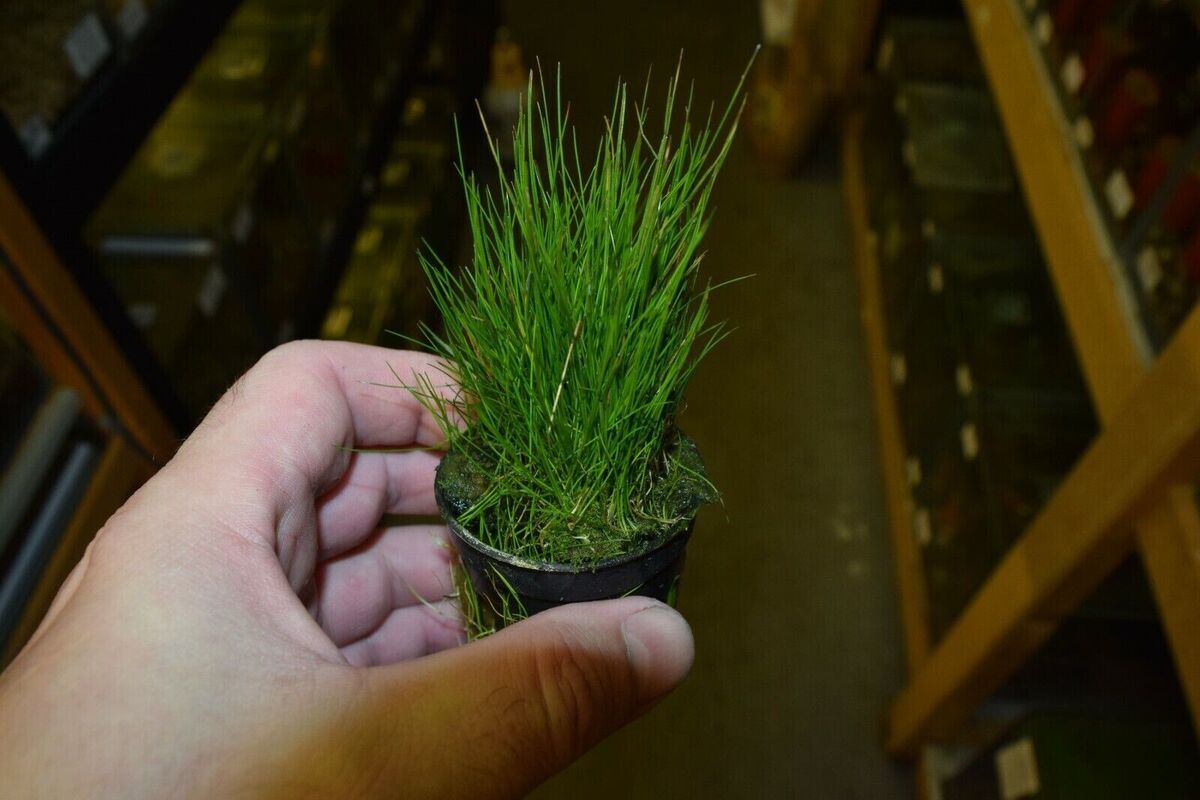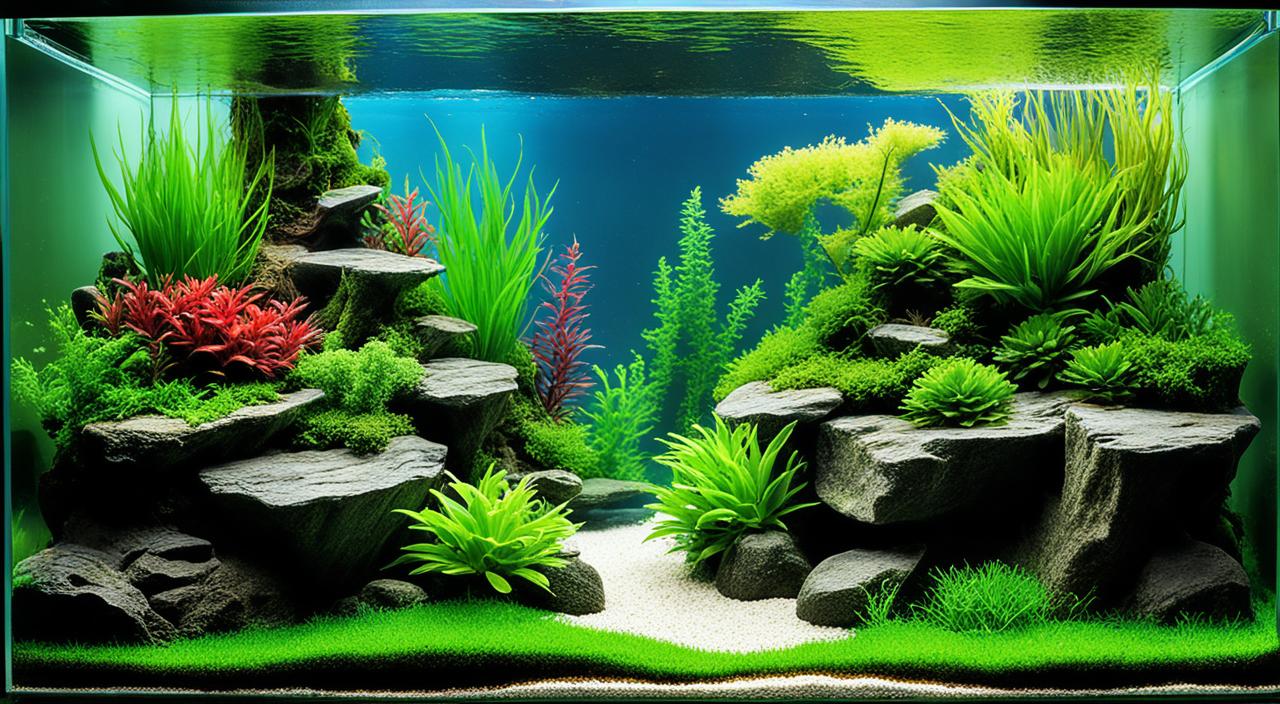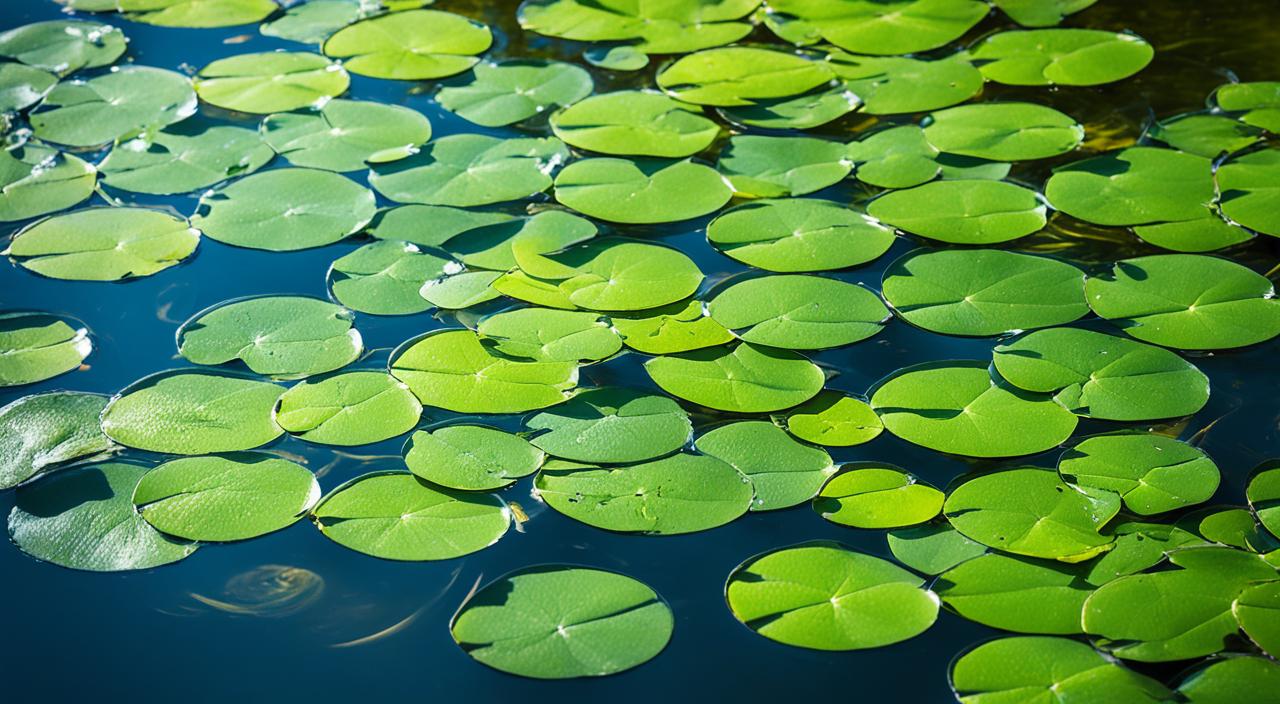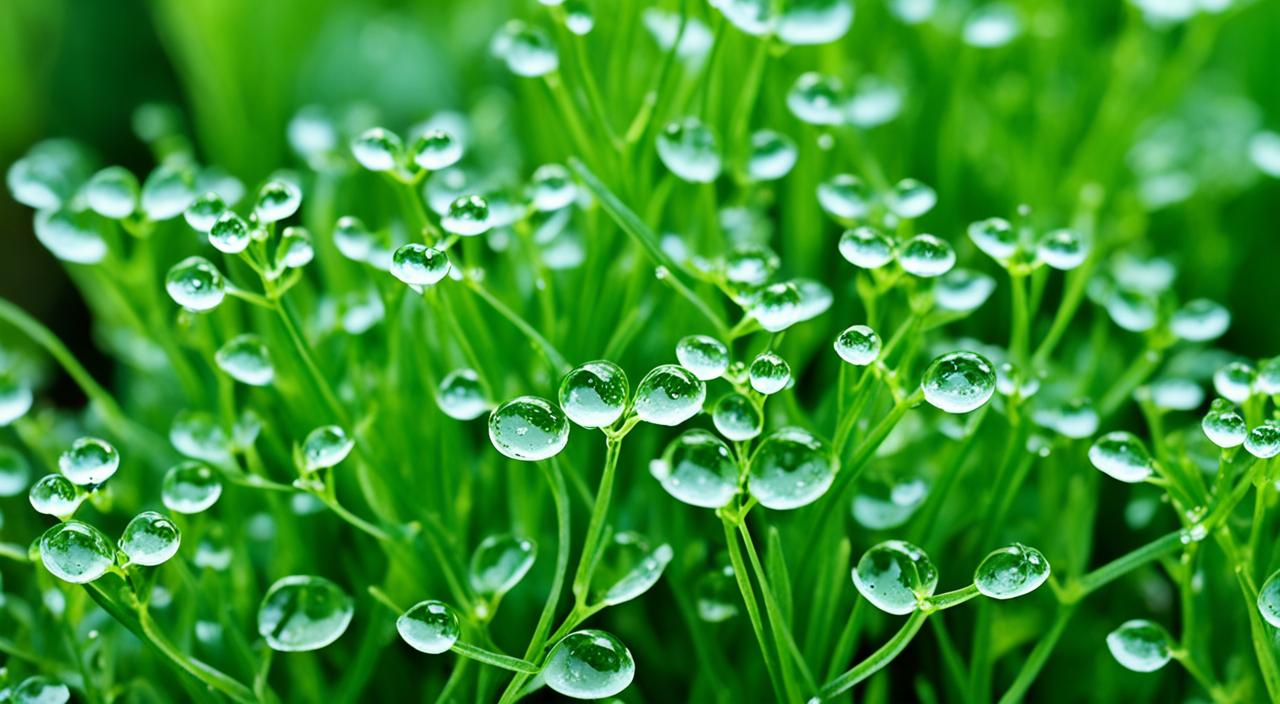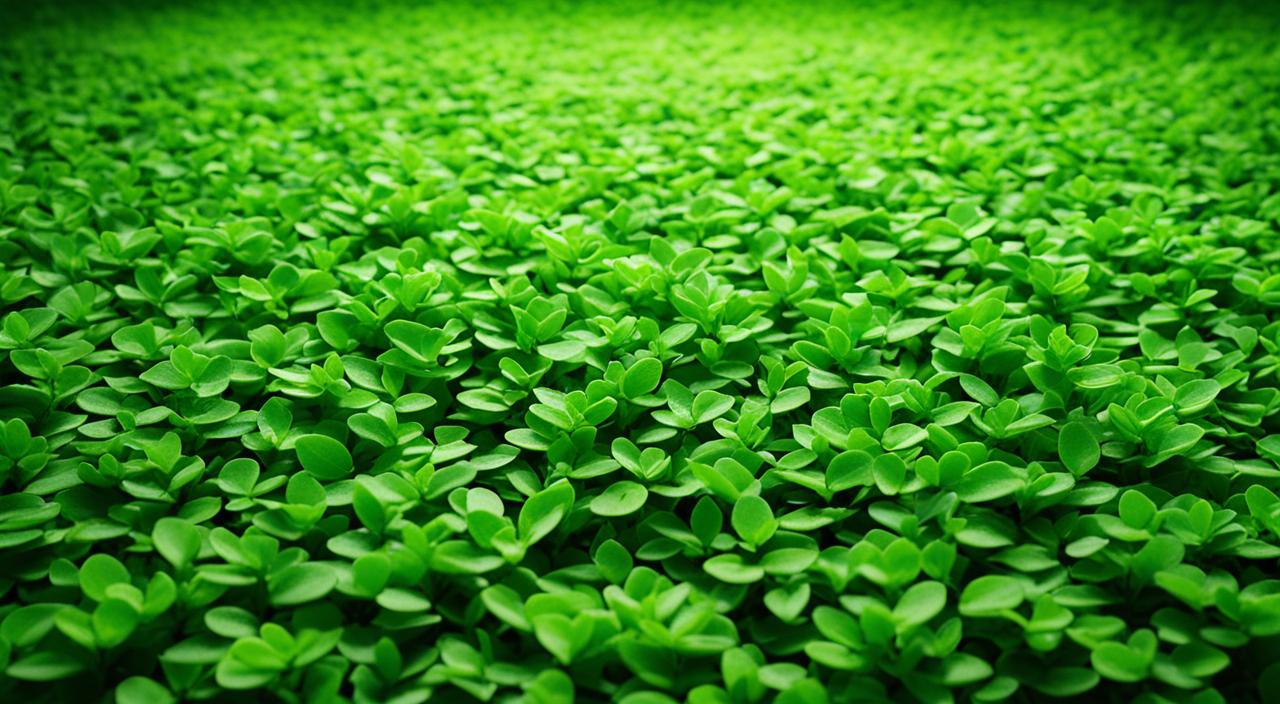What if you could capture that serene beauty within the glass walls of your aquarium? Eleocharis acicularis, or Needle Spikerush, allows you to create a miniature aquatic meadow, transforming your aquascape into a serene, living artwork. This versatile plant is the perfect choice for aquascaping enthusiasts looking to add a touch of natural beauty to their underwater landscapes.
Eleocharis acicularis, commonly known as the Needle Spikerush, is a highly adaptable aquatic plant that forms dense mats of slender, grass-like stems and delicate green leaves. It is native to various regions worldwide, including Europe, Asia, North America, and South America, and thrives in aquatic and terrestrial environments.
By incorporating Eleocharis acicularis into your aquarium, you can create lush carpet-like growth that enhances the aesthetics of your aquascape, provides shelter for fish, and promotes breeding. It’s graceful appearance and vibrant green colour make it a popular choice among aquascaping enthusiasts looking to capture the beauty of nature within their tanks.
Key Takeaways:
- Eleocharis acicularis, or Needle Spikerush, is a versatile aquatic plant that can create a stunning carpet-like growth in your aquarium.
- This plant is known for its slender, grass-like stems and delicate green leaves, which provide a serene and natural aesthetic to your aquascape.
- Eleocharis acicularis is adaptable to aquatic and terrestrial environments, making it a versatile choice for aquascaping.
- Incorporating Eleocharis acicularis into your aquarium enhances its visual appeal, provides shelter for fish, and promotes breeding.
- Eleocharis acicularis can transform your aquascape into a serene, living artwork with proper care and maintenance.
Introduction
Welcome to the exciting world of aquascaping and underwater gardening! This section will provide an overview of Eleocharis acicularis, called Needle Spikerush, and explore its significance in creating stunning aquatic landscapes. Whether you’re a seasoned aquarist or just starting, Eleocharis acicularis offers endless design possibilities and can transform your aquarium into a captivating underwater paradise.
Overview
Eleocharis acicularis, commonly known as Needle Spikerush, is a versatile aquatic plant highly valued for its ability to create lush carpet-like growth in aquariums.
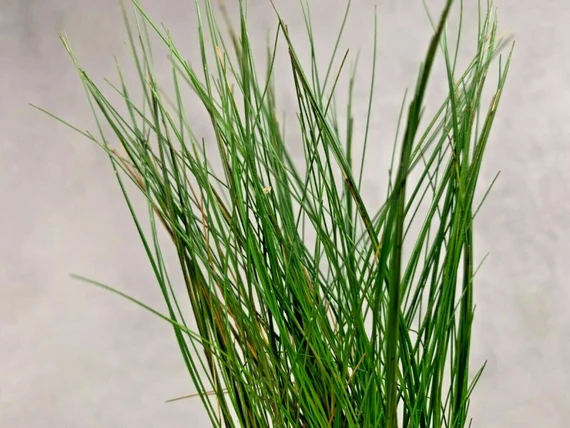
Its thin, grass-like stems and creeping rhizomes make it ideal for aquascaping, as it forms dense mats that provide shelter for fish and promote breeding.
This species is native to Europe, Asia, North America, and South America and has gained popularity among aquascaping enthusiasts for its adaptability and the natural touch it adds to aquascapes.
Origin and Habitat
Eleocharis acicularis is found in diverse aquatic and terrestrial habitats worldwide. It thrives in moist areas such as marshes, lakeshores, and the edges of ponds and streams. In the wild, it plays a crucial role in freshwater ecosystems by providing habitat for aquatic organisms and contributing to the overall ecological balance.
When it comes to aquascaping, Eleocharis acicularis is a go-to plant for creating depth and adding a natural touch to freshwater aquariums. Its ability to form a dense carpet-like growth across the substrate creates a visually appealing landscape that mimics the lushness of natural water bodies.
Eleocharis acicularis can transform your aquarium into a captivating underwater garden, providing a stunning backdrop for your aquatic inhabitants.
Morphological Characteristics
In this section, we will provide a detailed description of Eleocharis acicularis’s morphological characteristics. Understanding this plant’s physical attributes is essential for maintaining its health and ensuring proper growth in the aquarium. Additionally, we will emphasize the importance of proper aquatic plant care for maintaining a thriving tank ecosystem.
| Attributes Names | Descriptions |
|---|---|
| Scientific name | Eleocharis acicularis |
| Common Names | Needle Spikerush, Hairgrass |
| Origin | Worldwide |
| Size | Up to 10 inches (25 cm) in height |
| Growth Rate | Medium to Fast |
| Colour | Bright Green |
| Life Span | Perennial |
| Diet | N/A (Photosynthetic) |
| pH | 6.0 – 7.5 |
| Care Level | Easy to Moderate |
| Light Requirements | Medium to High |
| APPEARANCE | Slender, needle-like leaves |
| Temperature | 50-77°F (10-25°C) |
| Flow Rate | Moderate |
| Minimum Tank Size | 10 gallons (38 liters) |
| Recommended Tank Size | Stones driftwood for natural look |
| Substrate | Fine sand to small-sized gravel |
| Decor | Stones driftwood for a natural look |
| Filtration | Required for water quality, but gentle flow preferred |
Description
Eleocharis acicularis, commonly known as Dwarf Hairgrass, is a delicate aquatic plant with slender leaves and stems. When densely planted in the aquarium substrate, its grass-like structure creates a visually appealing carpet effect. The plant also produces small florets on a spike, adding subtle yet beautiful texture to the overall appearance.
Size
Eleocharis acicularis is a relatively small plant, typically growing to 2 to 4 inches (5 to 10 centimeters) in height. Its compact size makes it suitable for various aquarium setups, including nano tanks and low-light environments. The plant’s ability to form a dense carpet makes it an excellent choice for creating visually striking landscapes in the aquarium.
Colour Variations
Eleocharis acicularis exhibits different colour variations depending on the lighting conditions and water parameters. Under intense lighting and adequate nutrient availability, the plant can display vibrant green hues, adding a refreshing touch to the aquarium.
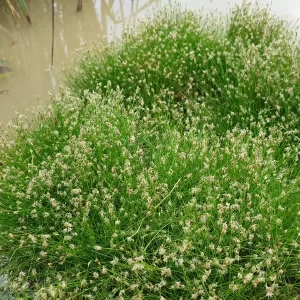
In lower light conditions, it may appear slightly lighter or more subdued in colour. Aquarists can achieve the desired colour variations by utilizing proper lighting and managing water parameters, creating a stunning aquarium ground cover.
| Aquatic Plant | Growth Rate | Lighting Requirement | Care Level |
|---|---|---|---|
| Eleocharis acicularis | High | Low to Moderate | Easy |
| Nymphaea lotus | Medium | Moderate to High | Moderate |
| Anubias barteri | Slow | Low to Moderate | Easy |
Table: Comparison of growth rates, lighting requirements, and care levels of popular aquatic plants. Eleocharis acicularis stands out with its high growth rate, making it suitable for achieving a lush carpet effect in the aquarium.
Habitat Requirements
Creating the ideal habitat for Eleocharis acicularis is crucial for its optimal growth and health. This section will explore the critical habitat requirements, including water parameters, substrate, lighting, and CO2 and nutrient supplementation.
Water Parameters
Maintaining the appropriate water parameters is essential to ensuring the well-being of Eleocharis acicularis. This plant thrives in a temperature range of 68°F to 82°F (20°C to 28°C) and prefers a slightly acidic to neutral pH level of 6.0 to 7.5. Additionally, providing water hardness between 2 to 12 dKH (35 to 214 ppm) benefits its growth.
Substrate
The substrate plays a vital role in supporting the root development and anchoring of Eleocharis acicularis. A fine-grained substrate such as sand or specialized aquascaping substrate is recommended. This type of substrate allows the plant’s delicate roots to establish a stronghold, promoting healthy growth.
Lighting
Proper lighting is essential for Eleocharis acicularis’s photosynthesis and overall health. This plant thrives in low to moderate light conditions, making it suitable for aquariums with low light levels. Providing a lighting intensity of 0.5 to 2 watts per gallon or 0.13 to 0.53 watts per litre will ensure optimal growth and prevent excessive algae growth.
CO2 and Nutrients
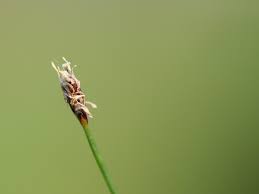
Carbon dioxide (CO2) supplementation can significantly enhance the growth and overall health of Eleocharis acicularis. CO2 injection systems help to maintain adequate carbon dioxide levels in the water, promoting robust growth and lush carpet-like mats.
Additionally, providing essential nutrients, such as nitrogen, phosphorus, and potassium, through liquid fertilizers or root tabs will ensure Eleocharis acicularis receives the nutrients necessary for its thriving growth.
Planting and Propagation
Proper planting and propagation techniques are essential for incorporating Eleocharis acicularis into your aquascape. This section provides step-by-step guidance on planting, root development, propagation, and growth tips to ensure the healthy and vibrant growth of this versatile aquarium carpet plant.
Planting Techniques
To plant Eleocharis acicularis, follow these simple steps:
- Prepare the substrate by removing any debris and creating a level surface.
- Anchoring the plant into the substrate: Gently insert the plant into the substrate, ensuring that the roots are buried and the stems are above the substrate.
- Ensure proper coverage: Space individual plants close together to achieve a carpet-like effect. Trim any excess height to maintain an even and lush appearance.
Following these planting techniques, you can create a visually appealing carpet of Eleocharis acicularis in your aquarium.
Root Development
The root development of Eleocharis acicularis is crucial for its overall health and growth. Healthy roots are vital in nutrient uptake, anchoring the plant in the substrate and preventing disturbances.
To encourage optimal root development:
- Provide a nutrient-rich substrate: Use a substrate suitable for aquatic plants that allow for proper root penetration and growth.
- Ensure consistent water conditions: Maintain stable water parameters to promote healthy root growth.
- Avoid disturbing the substrate: Minimize disturbances to prevent root uprooting and damage.
By prioritizing root development, you can enhance the vitality of Eleocharis acicularis in your aquarium.
Propagation
Propagation of Eleocharis acicularis can be achieved through both sexual and asexual reproduction methods.
- Sexual reproduction: Eleocharis acicularis produces small flowers that can develop into seeds. These seeds can be collected and germinated to grow new plants.
- Asexual reproduction: The plant’s runners or lateral stems can be carefully separated from the parent plant and replanted to establish new growth. This method allows for rapid propagation and expansion of the carpet.
Utilizing propagation techniques can help you create a lush and dense carpet of Eleocharis acicularis in your aquascape.
Growth Tips
To promote optimal growth and maintain the health of Eleocharis acicularis, consider the following tips:
- Provide adequate lighting: Eleocharis acicularis thrives in moderate to high lighting conditions. To support its growth and photosynthesis, ensure proper lighting intensity, duration, and spectrum.
- Maintain nutrient balance: Provide essential nutrients through fertilization, CO2 supplementation, and regular water changes. Monitor nutrient levels to prevent deficiencies or imbalances.
- Regular maintenance: Trim excess growth to maintain the desired carpet height and prevent shading of lower leaves. Remove any debris or decaying matter that may hinder plant growth.
Care and Maintenance
Routine Care
Incorporating routine care tasks is essential to ensuring the long-term health and aesthetics of Eleocharis acicularis in your aquarium. These tasks include regular trimming, fertilization, water changes, and algae control. Trimming the plant helps maintain its desired shape and prevent overgrowth, while fertilization provides essential nutrients for robust growth.
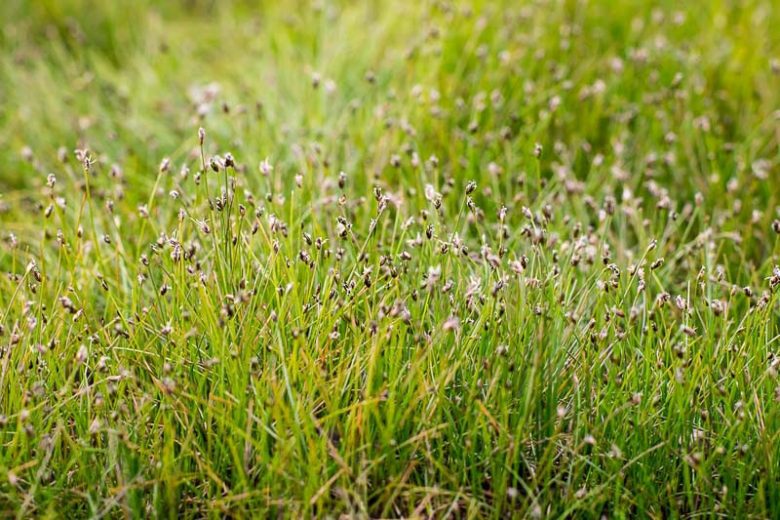
Regular water changes help maintain water quality and remove accumulated toxins, promoting a healthy environment for the plant. Implementing effective algae control measures, such as maintaining proper lighting and nutrient balance, helps prevent algae overgrowth that can compete with Eleocharis acicularis for resources.
Nutrient Deficiencies
Eleocharis acicularis requires a balanced supply of nutrients to thrive. Nutrient deficiencies can manifest as yellowing or stunted growth. To address nutrient deficiencies, water parameters must be monitored and fertilisation adjusted accordingly.
A comprehensive fertilizer regimen that includes key macronutrients (nitrogen, phosphorus, and potassium) and micronutrients (iron, magnesium, and others) is crucial for maintaining vibrant and healthy growth in Eleocharis acicularis.
Pests and Diseases
Despite its resilient nature, Eleocharis acicularis can be challenged by pests and diseases. Common pests that may affect this plant include snails, which can damage its delicate leaves and stems. Algae growth can also pose a threat, overshadowing and inhibiting the plant’s growth.
To prevent and control pests, the aquarium must be regularly inspected for signs of infestation, snails removed manually, and optimal water conditions maintained to limit algae growth.
Furthermore, certain diseases, such as fungal or bacterial infections, can impact the health of Eleocharis acicularis. Addressing any signs of disease promptly can help prevent its spread and preserve the plant’s vitality.
| Challenge | Solution |
|---|---|
| Algae Overgrowth | Check water parameters and adjust fertilization to provide adequate nutrients. Ensure proper lighting and CO2 levels for photosynthesis. If deficiencies are identified, consider supplementing with iron or other micronutrients. |
| Yellowing or Stunted Growth | Maintain proper lighting duration and intensity. Balance nutrients and CO2 levels properly. Implement effective algae control measures such as regular water changes, mechanical removal, and the use of algae-inhibiting substances if necessary. |
| Pests (Snails) | Regularly inspect the aquarium for snails and manually remove them. Avoid overfeeding, as excess food can attract snails. Introduce natural predators like assassin snails or loaches to control snail populations. |
| Algae Growth | Monitor Eleocharis acicularis for signs of disease, such as tissue discolouration or lesions. Isolate and treat infected plants to prevent further spread. Maintain optimal water conditions and avoid overcrowding to minimize the risk of disease outbreaks. |
| Diseases | Monitor Eleocharis acicularis for signs of disease, such as tissue discoloration or lesions. Isolate and treat infected plants to prevent further spread. Maintain optimal water conditions and avoid overcrowding to minimize the risk of disease outbreaks. |
Aquascaping with Eleocharis acicularis
Aquascaping is an art form that allows aquarists to create stunning underwater landscapes in their aquariums. One popular plant choice is Eleocharis acicularis, Needle Spikerush or Dwarf Hairgrass. This versatile plant adds depth, texture, and visual interest to aquascapes, making it a favourite among aquascaping enthusiasts.
Aquascape Styles
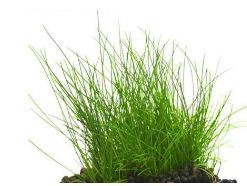
Aquarists can choose from various aquascaping styles, including Dutch, Nature, and Iwagumi. Eleocharis acicularis can be used to create beautiful aquascapes in different styles. In a Dutch-style aquascape, the carpet-like growth of Eleocharis acicularis can be used as a foreground plant, while taller plants are placed in the background to create a layered effect.
In a Nature-style aquascape, Eleocharis acicularis can be used to mimic a natural meadow or grassland, providing a sense of tranquillity and natural beauty. In an Iwagumi-style aquascape, Eleocharis acicularis can be strategically placed around rock formations to create a minimalist and serene landscape.
Companion Plants
When incorporating Eleocharis acicularis into an aquascape, it is crucial to consider companion plants that complement its growth habits, colours, and textures. Some suitable companion plants for Eleocharis acicularis include Anubias, Cryptocoryne, and Rotala. These plants can provide contrasting shapes, colours, and heights that enhance the aquascape’s overall aesthetics. Proper plant placement and design principles, such as the rule of thirds and the golden ratio, should be considered to achieve a balanced and cohesive aesthetic.
Aquascaping Tips
There are a few tips to remember when aquascaping with Eleocharis acicularis. First, to add visual interest, it is essential to create depth in the aquascape. This can be achieved by placing taller plants in the background and gradually decreasing plant height towards the foreground, where Eleocharis acicularis is located.
Secondly, hardscape elements such as rocks and driftwood can be incorporated to create focal points and enhance the overall design. Lastly, to achieve a sense of natural realism, factors such as plant spacing, irregular plant growth patterns, and incorporating natural elements like moss or tree branches must be considered.
| Aquascape Style | Description |
|---|---|
| Dutch | Aquascape with layered plantings, utilizing Eleocharis acicularis as a foreground carpet plant. |
| Nature | Aquascape that mimics a natural meadow or grassland, incorporating Eleocharis acicularis for a serene and tranquil effect. |
| Iwagumi | Minimalist aquascape with rock formations and strategically placed Eleocharis acicularis for a simple and serene landscape. |
Benefits in the Aquarium
Aquarium enthusiasts can benefit from incorporating Eleocharis acicularis into their freshwater tanks. This versatile plant offers both practical advantages and aesthetic appeal, from enhancing water quality to providing shelter and security for aquatic organisms. Let’s explore the various benefits of Eleocharis acicularis in detail.
Water Quality
Eleocharis acicularis plays a crucial role in improving water quality in the aquarium. The plant actively contributes to oxygenation, releasing oxygen during the day through photosynthesis. This provides a healthier environment for fish and other aquatic inhabitants.
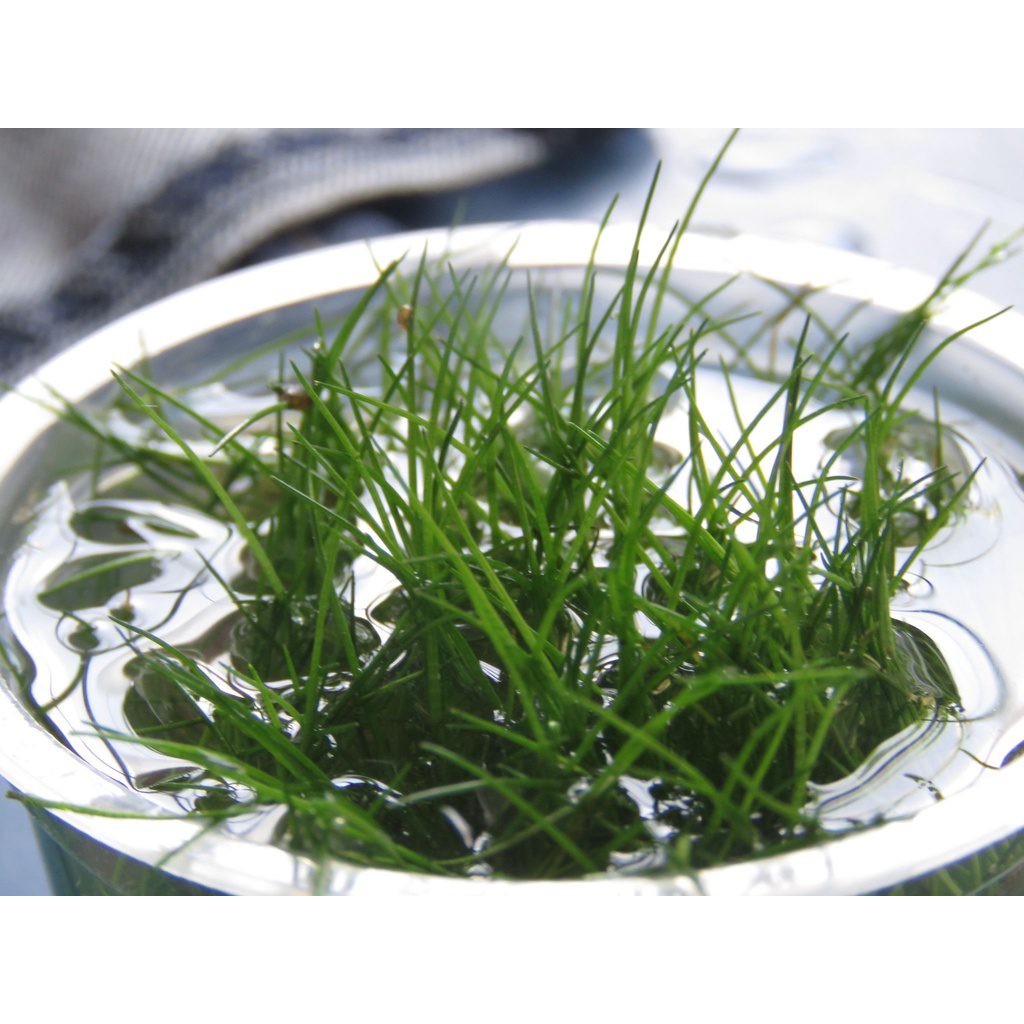
Furthermore, Eleocharis acicularis absorbs excess nutrients, such as nitrates and phosphates, reducing the risk of algae overgrowth. This plant acts as a natural filtration system, helping maintain a balanced ecosystem and promoting water clarity in the aquarium.
Shelter and Security
The dense mats created by Eleocharis acicularis offer a comfortable sanctuary for fish and other aquatic organisms. The plant’s carpet-like growth provides hiding spots, breeding grounds, and protection from predators, promoting the aquarium inhabitants’ overall well-being and natural behaviour.
Additionally, Eleocharis acicularis creates a natural habitat within the aquarium, mimicking the lush vegetation found in freshwater ecosystems. This enables aquarists to recreate a more authentic underwater environment and promote biodiversity in their tanks.
Aesthetic Benefits
One of the primary attractions of Eleocharis acicularis is its ability to create lush carpet-like growth, adding texture and depth to the aquascape. With its thin, grass-like stems, this plant forms an attractive carpet that covers the substrate, providing a visually appealing landscape for the aquarium.
Eleocharis acicularis’s vibrant green colour and delicate foliage add a natural beauty to any aquascape, creating a striking contrast against other plants, rock formations, or hardscape elements. Whether used as the main focal point or as a complementary element, this plant elevates the overall aesthetics of the tank, making it visually captivating.
By utilizing Eleocharis acicularis in their aquascape design, aquarium enthusiasts can create stunning underwater landscapes that enhance the overall beauty and tranquility of their freshwater tanks.
Challenges and Solutions
Common Challenges
When growing Eleocharis acicularis, aquarists may encounter several common challenges that can impede its thriving growth in the aquarium. These challenges include:
- Algae overgrowth: Excessive algae growth can compete with Eleocharis acicularis for nutrients and light, inhibiting its development.
- Improper growth patterns: Incorrect planting techniques or unfavourable environmental conditions may result in irregular growth patterns or sparse carpet formation.
- Nutrient deficiencies: Insufficient nutrient availability can lead to stunted growth, yellowing of leaves, and overall poor plant health.
- Pest infestations: Snails, algae, and other pests can damage or consume Eleocharis acicularis, hindering its growth and vitality.
Solutions
To overcome these challenges and maintain healthy and thriving Eleocharis acicularis in the aquarium, aquarists can implement the following solutions:
- Algae control measures: Regular aquarium maintenance, including proper lighting duration, nutrient dosing, and cleaning, can help control algae overgrowth and create favourable conditions for Eleocharis acicularis.
- Optimal planting techniques: Ensuring proper anchoring, substrate selection, and coverage can promote healthy growth and encourage Eleocharis acicularis to form a dense carpet in the aquarium.
- Nutrient management: Maintaining appropriate water parameters and supplementing with fertilizers or CO2 can address nutrient deficiencies and support robust growth in Eleocharis acicularis.
- Pest prevention and control: Implementing preventive measures, such as quarantining new plants and regularly inspecting the aquarium for pests, can help avoid infestations. If necessary, manual removal or targeted treatments can eliminate pests.
By understanding the challenges associated with growing Eleocharis acicularis and implementing proactive solutions, aquarists can ensure this aquatic plant’s long-term success and vibrant appearance in their aquariums.
Conclusion
Now that we have explored the various aspects of Eleocharis acicularis, it is evident that this versatile aquatic plant holds immense potential in aquascaping and underwater gardening. It can create lush carpet-like growth, enhance water quality, provide shelter for fish, and add aesthetic appeal to the aquarium, making it a valuable addition to any aquascape.
Throughout this article, we have discussed Eleocharis acicularis’s morphological characteristics, habitat requirements, planting and propagation techniques, and care and maintenance tips.
Aquarists can effectively incorporate Eleocharis acicularis into their aquariums by understanding these essential aspects, creating stunning underwater landscapes and establishing a thriving tank ecosystem.
Whether you are a beginner or an experienced aquarist, Eleocharis acicularis offers endless possibilities for creative aquascape designs. From Dutch-style setups to Nature and Iwagumi layouts, this plant can create depth, texture, and visual interest. Combined with suitable companion plants and proper maintenance routines, Eleocharis acicularis can become the highlight of your aquascape, transforming your aquarium into a captivating underwater paradise.
In conclusion, Eleocharis acicularis is more than just a plant; it is a key element in creating depth in the aquascape and elevating the aquarium’s overall aesthetics. By leveraging its unique features and following the guidelines provided in this article, aquarists can achieve a successful and visually stunning aquascape that will envy all who behold it.

